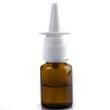Background
- Yoga enthusiasts have used nasal irrigation for thousands of years to clear the sinuses and the mind. Today, nasal irrigation is becoming more widely accepted as a home remedy for allergies, colds, and sinus infections. Nasal irrigation can be performed up to twice daily at home or in a doctor's office, as long as it does not irritate the mucous membranes.
- Saline lavage is a type of nasal irrigation that uses a warm liquid solution. Humidified warm air lavage (hyperthermia) uses heated mist, steam, or humidified air. Large-particle nebulized aerosol therapy uses a saline solution nasal spray. Occasionally, antibiotics are added to the solution.
- There is variability in nasal irrigation techniques. Differences include the method of saline delivery, the strength of the saline solution, and the use of other additives. Delivery methods include the traditional neti (irrigation) pot, nasal sprayer, bulb syringe, cupped hand, and commercially available devices. The strength of the saline solution depends on the amount of salt added to the water. Additives have included antibiotics, substances that narrow the blood vessels (called vasoconstrictors), and buffers, which reduce acidity. Some practitioners recommend buffered hypersaline solution, although this may irritate the nasal tissues. Gravity-fed normal saline is often used in Jali Neti, one form of nasal irrigation.
- There is growing evidence to support nasal irrigation because it is more natural, soothing, generally safe, and less expensive than many over-the-counter medications. It also does not cause side effects often associated with these medications, such as drowsiness and nausea.
- The International Consensus Report on the Diagnosis and Treatment of Rhinitis recommends nasal irrigation for the treatment of swollen nasal airways (called rhinitis). There is good evidence for the use of nasal irrigation in allergic rhinitis and sinusitis. There is also promising early evidence that nasal irrigation may help treat the common cold, respiratory symptoms from occupational exposure, and wounds after sinus or nasal surgeries. Nasal saline irrigation is still the main treatment for acute rhinitis in infants because excessive use of nasal drops that narrow blood vessels is unsafe in early childhood.
References
- Berger ME, Jones OW, Ricks RC, et al. Decontaminating the nasal passages. Health Phys 2003;84(5 Suppl):S80-S82.
View Abstract - Cordray S, Harjo JB, Miner L. Comparison of intranasal hypertonic dead sea saline spray and intranasal aqueous triamcinolone spray in seasonal allergic rhinitis. Ear Nose Throat J 2005;84(7):426-30.
View Abstract - Desrosiers MY, Salas-Prato M. Treatment of chronic rhinosinusitis refractory to other treatments with topical antibiotic therapy delivered by means of a large-particle nebulizer: results of a controlled trial. Otolaryngol Head Neck Surg 2001;125(3):265-269.
View Abstract - Friedman M, Vidyasagar R, Joseph N. A randomized, prospective, double-blind study on the efficacy of dead sea salt nasal irrigations. Laryngoscope 2006;116(6):878-82.
View Abstract - Garavello W, Di Berardino F, Romagnoli M, et al. Nasal rinsing with hypertonic solution: an adjunctive treatment for pediatric seasonal allergic rhinoconjunctivitis. Int Arch Allergy Immunol 2005;137(4):310-314.
View Abstract - Garavello W, Romagnoli M, Sordo L, et al. Hypersaline nasal irrigation in children with symptomatic seasonal allergic rhinitis: a randomized study. Pediatr Allergy Immunol 2003;14(2):140-143.
View Abstract - Greiff L, Anderson M, Wollmer P, et al. Hypertonic saline increases secretory and exudative responsiveness of human nasal airway in vivo. Eur Respir J 2003;Feb, 21:308-312.
View Abstract - Heatley DG, McConnell KE, Kille TL, et al. Nasal irrigation for the alleviation of sinonasal symptoms. Otolaryngol Head Neck Surg 2001;125(1):44-48.
View Abstract - Passali D, Damiani V, Passali FM, et al. Atomized nasal douche vs nasal lavage in acute viral rhinitis. Arch Otolaryngol Head Neck Surg 2005;131(9):788-790.
View Abstract - Rabago G, Manito N, Palomo J, et al. Improvement of chronic renal failure after introduction of mycophenolate mofetil and reduction of cyclosporine dose. J Heart Lung Transplant 2001;20(2):193.
View Abstract - Rabago D, Zgierska A, Mundt M, et al. Efficacy of daily hypertonic saline nasal irrigation among patients with sinusitis: a randomized controlled trial. J Fam Pract 2002;Dec, 51(12):1049-1055.
View Abstract - Ricchetti A, Landis BN, Maffioli A, et al. Effect of anti-fungal nasal lavage with amphotericin B on nasal polyposis. J Laryngol Otol 2002;116(4):261-263.
View Abstract - Shin SH, Ye MK. Effects of topical amphotericin B on expression of cytokines in nasal polyps. Acta Otolaryngol 2004;124(10):1174-1177.
View Abstract - Tano L, Tano K. A daily nasal spray with saline prevents symptoms of rhinitis. Acta Otolaryngol 2004;124(9):1059-1062.
View Abstract - Wormald PJ, Cain T, Oates L, et al. A comparative study of three methods of nasal irrigation. Laryngoscope 2004;114(12):2224-2227.
View Abstract







